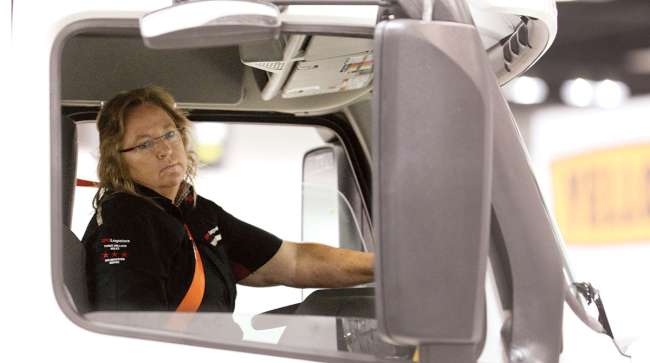Staff Reporter
Freight Trends Continue to Affect Driver Recruitment

[Stay on top of transportation news: Get TTNews in your inbox.]
The trucking industry likely will see a continued slowdown in driver recruitment efforts as freight demand continues to normalize in 2023.
“I think you’re going to see less money spent on recruiting over the next six months than the first six months of 2022,” Cowen and Co. analyst Jason Seidl said. “Over the last several years, we’ve seen drastic driver wage increases. I might add, well deserved.
"The men and women who deliver freight across our great country have been underpaid and underappreciated, and I think some of that has changed and changed for the better. But I think the magnitude of the rate increases that we saw lessened and then in some cases they may stall for a bit.

Seidl
The coronavirus pandemic brought with it high freight demand because of a variety of factors such as consumer spending shifting toward goods over services. Thus, carriers made a significant push to recruit drivers to meet that demand.
“There’s a sectoral shift happening right now,” said Robert Boersma, vice president of operations at online jobs board Talent.com. “A natural one that is explainable from the pandemic. But there is money moving into other sectors. What we expect for 2023 is people are going to want to get travel and hospitality out of their system. We’ve been pent up for a long time; this year things finally opened up. But people want to travel. We see it with overwhelmed airports. We see it with lack of staff at restaurants and in the hospitality industry.”

Boersma
The Bureau of Labor Statistics reported that nonfarm payroll employment increased by 263,000 in November. Leisure and hospitality added 88,000 jobs. That includes 62,000 jobs in food and beverage establishments. But employment in transportation and warehousing declined by 15,000 and has decreased by 38,000 since July.
“That’s kind of what we expect. There’s going to be a significant shift in consumer dollars to spending money on restaurants, on traveling and on eating out,” Boersma said. “I think there’s obviously ripple side effects just because consumer dollars are going there instead of things like retail or buying TVs on Amazon or that sort of thing. Doesn’t mean there’s not still a lot of activity that happens in transportation.”
Fleet telematics company Samsara foresees the macroeconomic environment and challenges its customers have been facing will remain top of mind into 2023. That includes fuel costs, tight labor markets and supply chain pressure.

Hausman
“It’s become paramount that organizations treat these problems as data problems and enable individual employees with the right information at the right time,” said Jeffrey Hausman, chief product officer at Samsara. “As operations become more connected, a proliferation of data will continue across industries such as trucking, construction and manufacturing. In addition, there will be an increased importance on data that’s made easily accessible to individual employees on the front line.”
Hausman added real-time insights, alerts and reports made available to workers will help them make data-driven decisions and accelerate time to action. He believes companies that take this approach will gain a competitive advantage in terms of operational efficiency and employee retention.

Dismuke
“I think Q1 is going to be very interesting with the economy so unpredictable right now,” said Scott Dismuke, vice president of operations at the Professional Driver Agency. “You’ve got the Fed raising interest rates, you’ve got the inflation numbers, but there’s also other segments of the economy as far as unemployment rates and things like that that don’t really point to a recession.”
Dismuke noted that the holiday shipping season hasn’t seen as much of a peak for freight demand this year. The question he is focused on is whether that trend will continue into next year. He believes that it probably will.
“I think that Q1 is definitely going to be interesting as it relates to what the economy does, what the Fed continues to do,” Dismuke said. “The sense that I’m getting from the folks I talk to is just some uncertainty. I think that is probably the best word to describe what next year looks like. Cautious optimism that it’s not going to be as bad as some people are saying.

Host Michael Freeze relays the story of a cybersecurity crisis at a transportation and supply chain management company and discusses strategies to avoid cyberattacks with a 30-year veteran of automotive cybersecurity systems. Hear a snippet, above, and get the full program by going to RoadSigns.TTNews.com.
"I think we’ve seen a little bit better economic news, at least in the last month. There were some good indicators. But we’re still obviously seeing inflation at 20-year or 30-year highs that could continue to affect what the economy does. So, I just think there’s more questions than answers going into ’23.”
Boersma noted the shifting in consumer trends also is compounded by higher interest rates, making money more expensive, and a slowdown from home builders and developments. He noted that both require transportation.
“I think there are some buying habits that have stuck and are never going to go away,” Boersma said. “People have shifted the way that they’re buying things like groceries, like home items, ordering way more from online retailers than they ever had.
“So even if some of that money is going to other sectors right now, I don’t foresee things going back to exactly the level of pre-pandemic. I think there’ll be a new, sustained increase. But proportionally, I think we can expect to see less growth. That’s what we can expect for next year.”
Want more news? Listen to today's daily briefing below or go here for more info:




